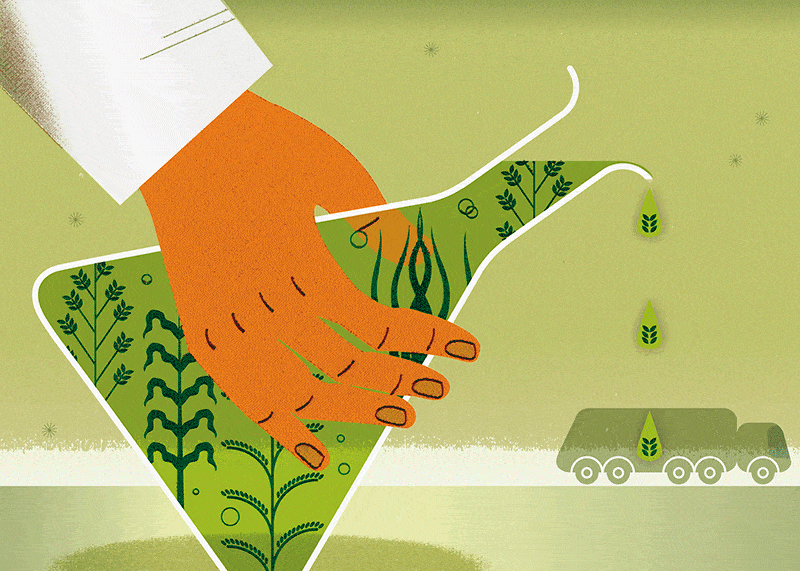Mangroves in Oman
One million seedlings planted and an integrated plan for care and development

Bader bin Yousef Al Balushi
Assistant Director of the Department of Marine Conservation in the Sultanate of Oman
Mangroves have always been considered one of the most important benthic biological habitats that characterize the coasts of tropical and subtropical countries in more than one coastal region in the world, due to their role in maintaining the ecological balance, and the multiplication of common and commercially valuable fish and other marine organisms that are natural incubators for them, as well as being areas with stunning and attractive landscapes.
Mangroves belong to hardwood plant species that are resistant to rotting and decomposition, and grow continuously, albeit at slow rates, due to the extremely difficult environmental conditions in which they grow and grow. Most types of mangroves are also characterized by their resistance to salinity and the presence of more than one mechanism to resist and get rid of excess salts, such as the presence of special salt glands that help the plant to secrete and expel salts, although there are other types of mangroves that concentrate salts in their leaves, which in turn fall after that, to get rid of salts in this way.
Ecosystem benefits Growing mangroves in coastal areas
requires a number of basic factors, such as the right temperature, non-super salinity, fairly soft clay soil, and an appropriate range of tidal currents as well as waves, so that these intense currents or waves do not harm the plant or its seeds.
In most locations, mangroves usually grow in swamps and rich soils, often formed from mud and viscous mud containing a large amount of nutrients formed by the biodegradation of leaves and fruits by microorganisms and other chemical reactions. Mangrove forests have always been considered a suitable environment for mosquitoes to breed, mud accumulation and dirty organic remains, but this negative idea changed over the years, when the importance of these trees and the value of the water and sedimentary environment in which mangroves grow became clear.
This ecosystem of the Qurum is one of the most important ecosystems that contribute to the enrichment of biodiversity, due to its attraction of large numbers of birds and marine organisms micro and inaccurate, not to mention being a natural incubator for many types of fish, shrimp, crustaceans, shellfish, crabs and other marine organisms, as the young of these organisms usually grow in those areas before moving to deep waters.
In addition, they play a key role in protecting beaches from erosion by stabilizing coastal soils and preventing sediment erosion. It also contributes to reducing greenhouse gas emissions and carbon dioxide sequestration, thus helping to reduce the effects and repercussions of climate change on the planet.
Man has known the importance of Mangroves since ancient times, so he used its wood to build houses, boats, fences and wooden carvings, and used its bark to make paper pulp and extract a number of medical drugs.
Steady population growth and growing pressures due to human activities
have contributed to the growing threat to mangrove forests, especially as most of them grow in coastal areas, which are naturally targeted for tourism development, recreational activities, urban expansion and others. The negative actions associated with these activities have led to the misuse of these forests, causing their area to decline in a large number of areas and leading to their disappearance from other areas. Other coastal ecosystems, particularly coral reefs and sea meadows, have also been affected, due to the existence of an inherent and strong reciprocal and symbiotic relationship between mangroves as a single system and these systems. For example, mangrove trees and forests off the coast purify the water from excess turbidity and suspended sediments that suffocate the reefs and spoil the clarity of the surrounding waters, while the reefs calm the sea waves and the strength of tidal currents heading to the shore, thus reaching quietly the sites and areas where the Qurum is located.
Other activities, such as herding workers cutting down mangroves or plant leaves to feed their camel, sheep and goat livestock or to use them as animal feed, have affected more trees. Some beachgoers resort to wrong practices, including fishing small fish and shrimp larvae in large quantities, as well as collecting snails, shells and some crustaceans, practices that harm the ecological balance in the Mangrove environment and affect in one way or another the available fish stocks.
There is no room here to list all human activities and practices harmful to this distinct habitat, but we must be aware that the ecosystem of any biological habitat, especially Mangrove, as a sensitive benthic habitat, has a limit of tolerance and absorption capacity for damage, which means that exceeding this limit will inevitably lead to the loss of many of the benefits and services it provides.
Mangroves in Oman
Oman has a long coastline stretching for 3165 km, rich and diverse with natural resources, enchanting scenery and biological habitats. Over the centuries, its inhabitants have played an important role in the trade and cultural exchange between the peoples and civilizations adjacent to the Arabian Sea and the Indian Ocean. The mangroves were a witness to this historic struggle, as Omani merchants had long traded in mangrove timber and seeds on their sea voyages for foreign trade. For example, archaeological excavations found near the Mangrove Nature Reserve in the capital Muscat have indicated the presence of mangroves in this area and their exploitation by hunters for more than four thousand years.
One species of mangroves, known as the Mangrove or Black Mangrove Avicennia Marina, is predominantly in Oman, which has adapted efficiently to Oman's hot weather environment and scarce fresh water, extending along the country's coastline with a total total area of about a thousand hectares or more. This species is distributed in several coastal areas on the coasts of the Sea of Oman and the Arabian Sea, starting from the Batinah region in the north, passing through the capital Muscat, the Eastern Province and the Central Region, and reaching the Dhofar Governorate in the south. The Qurum region near the capital Muscat is one of the most famous areas of this plant in the Sultanate. In addition to the Mangrove Park, this type of tree is also heavily spread in Bandar Al Khairan and Qurayyat in Muscat, Khor Al Qurum Al Kabeer and Khor Al Qurum Al Sagheer in Dhofar Governorate, Shinas and Liwa in Al Batinah Region, Khor Sur, Grama and Masirah Island in the Eastern Province and Mahout in the Central Region. According to one study, these reserves are home to more than 40 species of crustaceans, 200 species of birds, more than 80 species of mollusks, as well as more than 100 species of fish and other marine organisms.
Aware of the importance of mangrove forests and believing in their vital role in maintaining the ecological balance and enriching biodiversity, in addition to being attractive natural areas of great tourist value, the Sultanate of Oman, represented by the Environment Agency, has paid great attention to them, preparing a promising plan for the conservation and management of mangroves, and more than one area at the level of the Sultanate has been declared a nature reserve, with the aim of protecting and preserving them from the injustice of human activities.
I was honored to be one of the contributors to this plan, especially since I have a love relationship with these trees, as I am a resident of the coastal areas of Muscat Governorate and live near the famous Qurum Nature Reserve. The Environment Agency of Oman has taken a number of practical steps to implement this plan, and has applied part of it to fully developed mangrove forests on a sustainable basis, because some of them can be economically rewarding for the local population, especially if they are used for honey farming, for example. Some of them can also be places of entertainment and tourism, while their active and permanent role in enriching marine biodiversity and the multiplication of fish and crustaceans is undeniable.
In addition to all these efforts, there is a promising project that began in the Sultanate in 2001 with the aim of planting one million mangrove seedlings, and since its inception until now, it has been able to cultivate about 700,000 seedlings. However, the ultimate objective of this project is to achieve full harmony between the sustainable regional development of mangroves while achieving the concepts of environmental conservation, and is part of a long-term plan to conserve the mangrove forests, natural resources and sensitive and productive coastal ecosystems that constitute one of the most important environmental features of the Sultanate of Oman.




